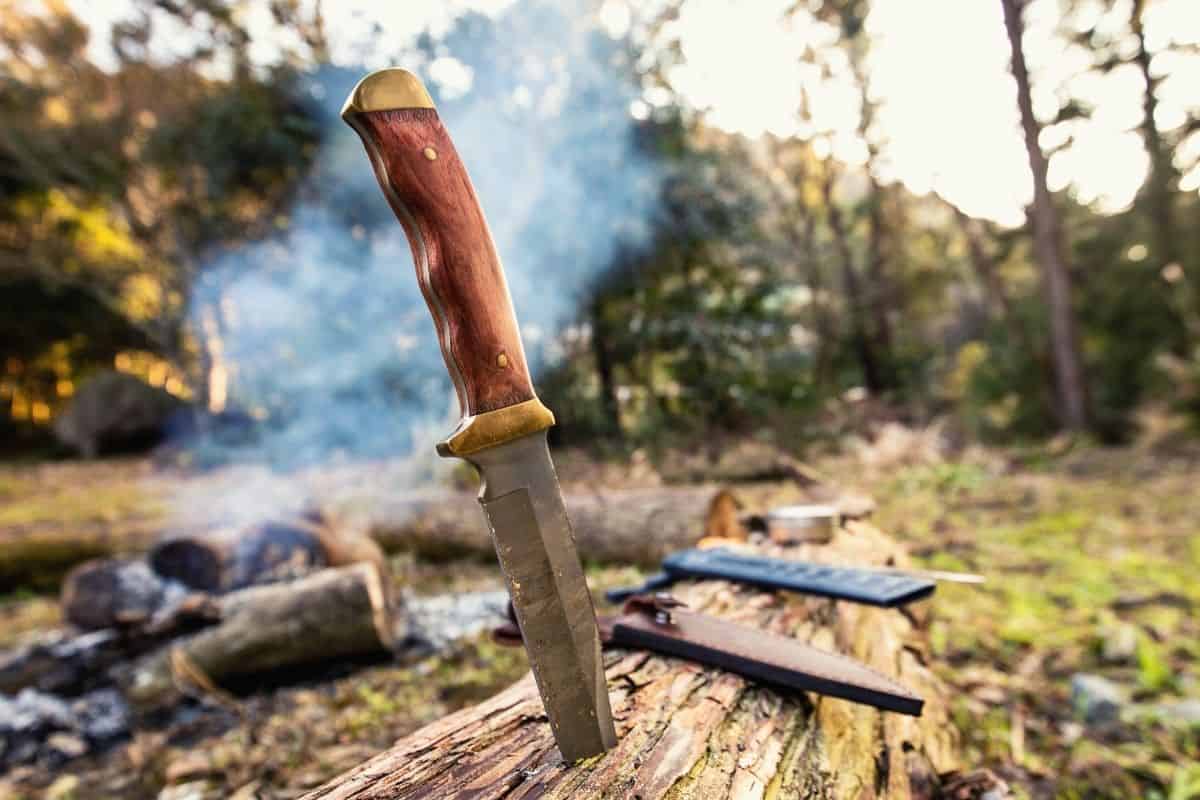A good knife can be a camper’s best friend. While you might not be using yours for fending off lions, bears, or crocodiles, à la Indiana Jones, you will need a reliable knife to complete many tasks around your campsite. From cutting wood to skinning game and preparing those evening meals.
In this article, we’ll go over the things every camper needs to know before purchasing a camping knife. We’ll share a few of our favorites to help you on your quest for the perfect blade, how to pick the best knife for your camping style, and why we’ve picked the Gerber Strongarm as our favorite.
Table of Contents
- Top Choices by Category
- What are the Best Camping Knives?
- Benefits And Features Of Camping Knives
- How To Choose The Best Camping Knife For Your Needs
- Advantages Of Fixed Blades Vs Folding Camping Knives
- What Is A Camping Knife Used For?
- Why You Should Avoid Multi-Tool Knives?
- Best Camping Knife: The Verdict
At a Glance: Quick Recommendations
-
Editor’s Choice:
Gerber Strongarm
“Tough, versatile, easy on the hand, and as durable as they come.” -
Best Value:
KA-BAR Becker Campanion BK2
“A full-tang, heavy-duty knife that allows you to take care of all camping chores with ease.” -
Best Budget:
Morakniv Companion
“Compact, lightweight, tough, and perfectly capable of handling most campsite tasks.” -
Best Camping Folding Knife:
Spyderco Endura 4
“A lightweight, flat-ground knife available with different blades and handles.” -
Honorable Mention:
StatGear 99416 Surviv-All Outdoor Knife
“A touch bulky but great value for money.” -
Premium Pick:
Benchmade Bushcrafter 162
“Pricey but ideal for buyers who won’t settle for anything less than the best of the best.” -
Best Pocket Knife:
Victorinox Swiss Army Pioneer X
“Exactly what you need if short on pack space”
Top Choices by Category
Budget picks: Morakniv Companion, StatGear 99416 Surviv-All, Victorinox Pioneer X Alox
Folding knives: Spyderco Endura 4, Victorinox Swiss Pioneer X Alox
Fixed-blade knives: Gerber Strongarm, KA-BAR Becker Campanion BK2, Morakniv Companion, StatGear 99416 Surviv-All, Benchmade Bushcrafter 162
What are the Best Camping Knives?
Gerber Strongarm
Editor’s ChoiceOregon’s Gerber Legendary Blades has become a household name in recent years thanks to an endorsement from survival expert Bear Grylls. Anyone interested in exploring this company’s extensive catalog should start their search with the Strongarm.
With a name like Strongarm, you’d believe this blade is…well, strong! Designers used durable 420 high-carbon steel in this blade’s construction. This makes the blade an ideal choice for people who expect to do a lot of chopping and sawing while in the wild.
The Strongarm’s drop point blade alone measures 4.75 inches, which makes it able to easily handle many arduous chopping tasks. Including the handle, the total length of the Strongarm is 9.8 inches. For weight, the Gerber Strongarm comes in at 10 ounces, which is lightweight for a heavy-duty, high-carbon model.
One nice detail of the Gerber Strongarm’s design is a curve on the handle that separates your finger from the blade. This safety holder will protect your hand from slipping while in use.
Another positive in the Gerber Strongarm’s favor is that it’s one of the easiest to customize. You could choose either a half-serrated or a fine edge blade design. If you think you’ll be doing a lot of sawing work, the half-serrated edge is a good option.
Besides choosing your blade’s style, the Gerber Strongarm comes in a wide array of colors. For those who want their blade to be discreet, you could order an all-black model. There’s also a black blade/brown handle and a gray design available.
Every Gerber Strongarm comes with a MOLLE strap in which you can lock your knife for added security and safety.
People used to handling a lightweight camping blade who are interested in transitioning to a high-carbon product should consider giving the Gerber Strongarm a try. This product has a lighter feel than other high-carbon products, but it has the weight necessary to perform all the tasks you’d expect of these blades.
PROs
- Strong high-carbon blade
- Ergonomic handle design
- Mid-range 10oz. weight makes it easy to transition into
- Wide variety of blade designs and color schemes to choose from
- Flat grind ideal for food prep
- Finger groove for easy handling
CONs
- No bright colors or glow-in-the-dark options
- Lightweight – not ideal for a ton of heavy work
Bottom-Line: A tough, well-designed workhorse that makes easy work of campsite tasks both little and large.
KA-BAR Becker Campanion BK2
Best ValueThe KA-BAR BECKER BK2, is our value pick with a great balance of strength and price.
Designed by legendary knife expert Ethan Becker, the KA-BAR BECKER BK2 has a thick 1095 cro-van steel blade. The best three words to describe this blade are wide, thick, and heavy. You’ll get good use out of this blade if you do a lot of heavy-duty chopping tasks.
The KA-BAR BECKER BK2 is a full-tang, fixed-blade knife, which makes it one of the strongest and most supportive on our list. And at 0.25-inches thick, it is also virtually indestructible. Another nice feature on this blade is a choil by the handle which can help you with blade sharpening and striking rods, or used as a fire starter.
PROs
- Thick and strong cro-van steel blade
- Designed by celebrity chef Ethan Becker
- Convenient choil for sharpening and lighting fires
- Blade coating and handle can be switched out for other KA-BAR products
- Excellent edge retention
- Lanyard hole
CONs
- Nylon sheath can dull blade over time
- Blade requires maintenance to prevent rusting
Bottom-Line: A good option for buyers who want a heavy-duty blade at a fair price.
Morakniv Companion
Best BudgetThe Morakniv Companion is one of the cheapest blades on our list, but is still capable of getting the job done. In total, the Companion measures 8.8 inches and weighs only 4.8 ounces. While the smaller blade size and lighter weight will put off some potential buyers, it’s worth noting that the high-carbon blade is robust, durable, and more than large enough for most chores at camp.
The rubber handle is large and offers a ton of grip support. As you feel this handle, you will notice that you’re not getting full tang stability, but this is the trade-off when buying a model at the lower end of the price scale.
Another drawback of the Morakniv Companion is that the spine isn’t designed for striking a ferro rod, so you will have to make a few modifications and sharpen the back edge if you want to get sparks going in the wild.
There are two main designs of Morakniv Companion Knives to choose from – discreet camouflage-style or bright orange. Whichever design you choose, you’ll get a lifetime warranty. In addition to the lifetime warranty, customers get a plastic sheath with a belt clip.
While there are obvious drawbacks to the Morakniv Companion, this blade can handle basic tasks. The powerful high-carbon blade is also durable, and the blade’s lightness makes it easy to carry.
PROs
- High-carbon steel blade designed in Sweden
- Large handle with good grip support
- Discreet or bright color designs to choose from
- Conveniently lightweight and small
- Lifetime warranty
CONs
- This blade is smaller than most others on this list
- Doesn’t offer support of a full-tang blade
- Spine needs modifications for ferro rod lighting
Bottom-Line: A good pick for campers seeking a bargain and who don’t mind sacrificing the stability of a full-tang camping knife. Also our pick for the best backpacking knife.
Spyderco Endura 4
Best Camping Folding KnifeThe Spyderco Endura 4 measures 5 inches closed and weighs less than 4 ounces, so you should have no issues fitting this in your pocket. When you open up your Endura 4 it will measure 8.75 inches. Spyderco Endura 4’s flat, saber-ground blade is made of Japanese VG-10 stainless steel that measures 3.75 inches long and 0.125 inches thick.
For safety, the manufacturers have placed a 0.5-inch diameter hole on the blade and a pocket clip on the handle. You can put your finger through the smooth spider hole to aid pushing the blade in.
There’s a nice thumb ramp in between the blade and handle for additional safety. You can switch the tip up or down to suit your preference.
As for the handle, it’s made out of fiberglass-reinforced nylon and measures 5 inches. There are traction scales on this handle to help you get a firm grip and these are particularly handy when working in sweaty conditions.
This Spyderco Endura 4 won’t be able to complete heavy-duty tasks with the speed and efficiency of a full tang product. Nevertheless, it’s perfect for campers who go on occasional trips and want a small, pocketable folding knife for camping.
PROs
- One of the lightest and most discreet knives on our list
- Impressive weight considering the blade’s length and thickness
- “Spider hole” helps safely push in folding blade
- High-quality Japanese steel
- Razor-sharp from the box
CONs
- Less stability than a full-tang knife
- Short blade length not well suited for heavy-duty tasks
- Quite pricey
Bottom-Line: An ultralight folding knife that excels with more delicate and precision-oriented tasks.
StatGear 99416 Surviv-All Outdoor Knife
Honorable MentionThe StatGear 99416 Surviv-All Outdoor comes with a 440 stainless steel drop point blade that measures 4.25 inches. This product is full tang and the blade has a stylish black finish. With the handle, the Surviv-All measures 9.5 inches.
As for weight, the StatGear 99416 will add 7.5 ounces to your travel sack out of the sheath. With the sheath, the total weight is 15 ounces.
Speaking of the sheath, it’s one of the highlights. In addition to protecting your blade, this nylon sheath includes a ferro rod, blade sharpener, and strap cutter. All of these included features make the Surviv-All Outdoor a superb package for novice campers.
The Surviv-All Outdoor also locks into its sheath, meaning you don’t have to worry about it slipping out. For added safety, you can also strap the tight paracord around the handle while it’s in the sheath.
The Surviv-All also has a few nice features: a few green glow-in-the-dark strips on the top and bottom of the handle to help you find it at night and ergonomic curves near the blade to help you get a firm grip.
PROs
- Ideal for beginners
- Includes blade sharpener, ferro rod, sheath, and pommel
- 440 stainless steel blade
- Glow-in-the-dark markers help you find this blade at night
CONs
- Large sheath is a little inconvenient
Bottom-Line: This versatile knife is a little on the bulky side but impressively durable for a product so fairly priced.
Benchmade Bushcrafter 162
Premium PickThe Benchmade Bushcrafter 162 is another full-tang, drop-point blade, this time made out of CPM-S30V stainless steel.
Bushcrafter 162’s blade measures 4.4 inches and the handle 4.75 inches, giving a total of 9.15 inches. The blade thickness is 4.4 millimeters and the total weight (minus the sheath) is a fairly hefty 7.7 ounces.
The green G10 handle has scales to ensure it won’t slip or drop while in use, and also two thumb indentations where the blade meets the handle for better grip when performing more detailed work.
The buckskin leather sheath included with this product has a belt loop attachment. To ensure your blade is safe and secure when you’re on the move, the manufacturers have included a D-ring and a tight retention strap. There’s also a convenient loop for a ferro rod, though the rod itself isn’t included.
As you might guess from this description, the Benchmade Bushcrafter 162 is a luxury purchase, but in return for the added outlay, you’ll be getting some of the finest craftsmanship we’ve ever seen.
PROs
- Extremely durable and versatile stainless steel blade
- Ergonomic “coke bottle” handle design
- Comfortable sheath and D-ring included
- Lifetime warranty
CONs
- Ferro rod not included
- Pricey
Bottom-Line: A gorgeous bushcraft knife that’s easy and comfortable to use.
Victorinox Swiss Army Knife Pioneer X
Best Pocket KnifeIf you’re looking for a convenient, portable, and practical camping knife that has more tricks up its sleeve than a sharp blade alone, the Pioneer X Alox is a great pick.
While we’re big fans of regular fixed-blade or folding knives, this one was too much of a classic to leave off our list.
You won’t be splitting wood or doing much heavy-duty work with the Pioneer X’s 3-inch blade, granted, but it’s sharp for food prep and just about long and strong enough for a little bit of wood splicing.
In addition to that 3-inch blade, you get 8 more tools inside this tiny, incredibly lightweight package, including scissors, a punch can opener, a small screwdriver, bottle opener, and wire stripper key. If you’re swayed more by practicality and versatility than power, then, this one’s well worth considering.
PROs
- Sharp blade edge
- Ideal everyday carry
- Good for food preparation and fire prep
- Lightweight (3.25 oz.)
- 9 tools in total
CONs
- Much shorter and weaker blade than other knives on our list
Bottom-Line: A versatile, compact knife that offers all the quality you’d expect of a Victorinox offering.
Benefits And Features Of Camping Knives
What Is a Camping Knife Used For?
Anyone who has watched too many survivor TV shows might have the false impression that knives are necessary for ridiculous tasks like warding off bears and felling trees. In the real world, your camping knife will be used for more banal, but important, purposes.
How To Choose The Best Camping Knife For Your Needs
There’s a number of factors that will determine what makes a good camping knife for your needs, which you can see in the list below.
- Blade steel
- Blade length
- Blade Design
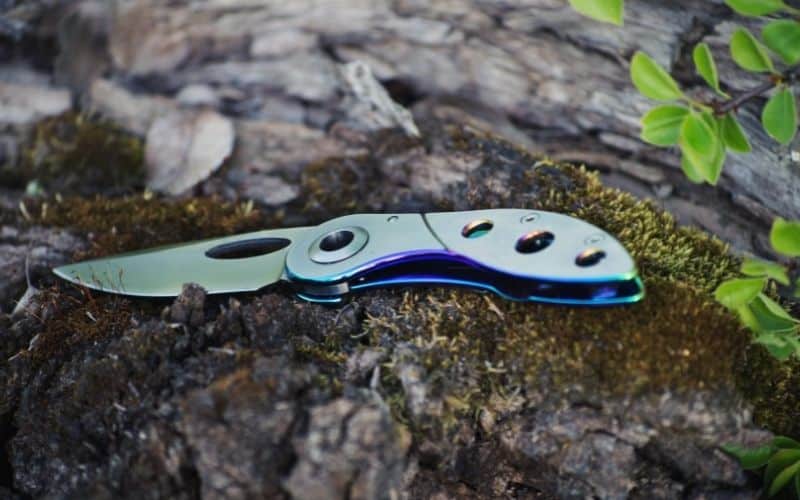
Blade Steel
The steel used for the blade will have a large impact on sharpness, strength and durability. While there are a few exceptions to this rule, stainless steel is the preferred choice. It’s easy to sharpen stainless steel blades and, unless you do a great deal of arduous cutting, it’ll take a long time for stainless steel to corrode or go blunt.
Any campers reading this article who are looking for strength in their blade should look for high-carbon steel. While carbon steel blades require more maintenance and rust faster than stainless steel if not cared for properly, these blades are known for being tough and maintaining a sharp edge.
Blade Length
Your choice of blade length will come down to the tasks you expect to carry out with your knife.
Avoiding a huge Rambo-style blade doesn’t mean you should pick up a tiny pocket knife that won’t be fit for the task. It’s important that your camping knife has a moderate amount of weight to provide it with better stability while you’re splicing wood.
The greater weight and thickness your blade has, the better it will be able to handle challenging tasks in the wild. Have a clear idea whether you’ll need your knife for less intense tasks like trimming or slicing kindling, or larger tasks like hacking larger pieces of wood. By first considering your needs, you should get a better sense of what blade is right for you.
Blade Design
The blade design can be subdivided into several further criteria given below.
- Serrated vs straight-edge
- Drop/Clip/Spear Point
- Choil
- Full Tang
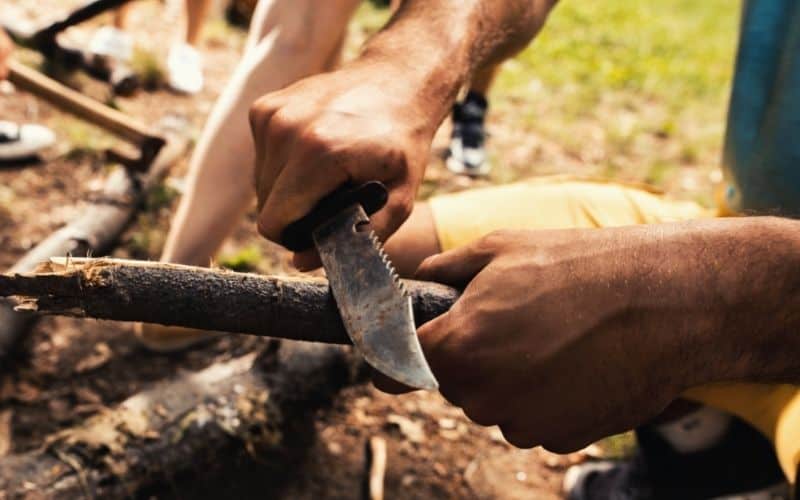
Serrated Versus Straight Edge
You’ll find dozens of articles arguing the pros and cons of serrated edge versus straight edge blades. Although there’s no “right or wrong” blade, experienced campers tend to side with straight edge blades.
Since there are no indentations in straight-edge blades, it’s simpler to get a more precise cut. Hikers find that it’s easier to handle a straight-edge knife when doing more detailed work with the tip. It’s easier to clean and sharpen straight-edge blades compared to a serrated blade.
Of course, this doesn’t mean that serrated knives don’t have any benefits. Serrated knives are praised for their ability to make slice cuts into rope and tough food items.
All of the blades on our list are straight-edge except for the Spyderco Endura 4, but don’t let that stop you from exploring the benefits of serrated knives. There are many half-serrated knives available today, giving you the benefits of both blades in one!
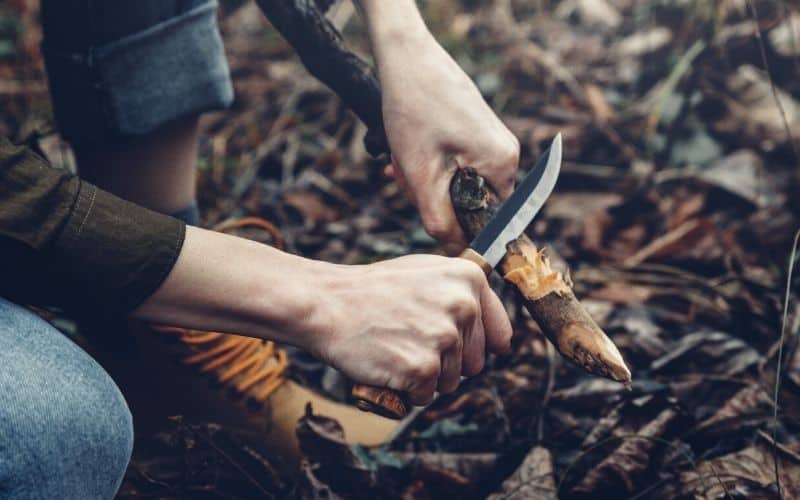
Drop/Clip/Spear Point
The type of point a knife ends in can be a drop, clip or spear point and each has it’s own benefits (and drawbacks) for different tasks.
Drop point blades, which have a convex curve that slopes to the blade’s point, are a common design style used in camping. If you’ve seen a Swiss army knife, you’ve seen a drop point blade.
Although they aren’t as popular, you might run across clip-point and spear-point blades in your search for a camping knife. As the name suggests, clip-point blades are “clipped” in the back, which makes them useful for piercing or picking.
With spear-point blades, on the other hand, the edges symmetrically lead towards the point. Daggers often use spear-point blades, which is the main reason they have such a powerful penetration strength.
Choil
Choils are tiny cutouts or indentations on the blade located near the handle. Choils can be used for helping to sharpen your blade’s edge or to light sparks with a ferro rod.
Full Tang
A full tang blade is one where the blade runs from the tip to the bottom of the handle, giving superior stability and strength.
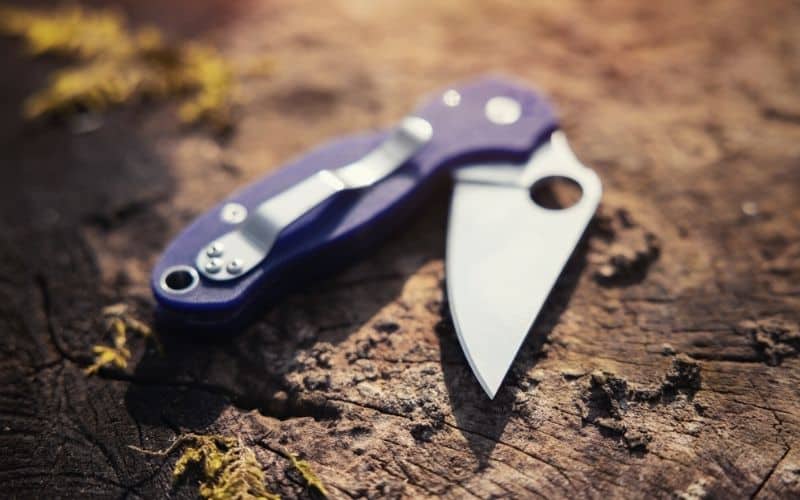
Advantages Of Fixed Blades Vs Folding Camping Knives
For experienced campers, fixed-blade camping knives are a better option than folding knives. Since a fixed-blade model has no moving parts, they perform better on difficult tasks like cutting wood. A fixed knife is quite simply sturdier than a foldable knife.
Inexperienced campers believe folding knives are safer than fixed blades because they can be stowed away when not in use. The truth is that more campers get cut by opening/closing folding knives than by a fixed-blade knife.
So why take a folding knife? Well, folding knives have the convenience factor. You can fit a good folding camping knife in your pocket without discomfort. And since folding blades are made more for convenience than durability, they’re cheaper than fixed blades.
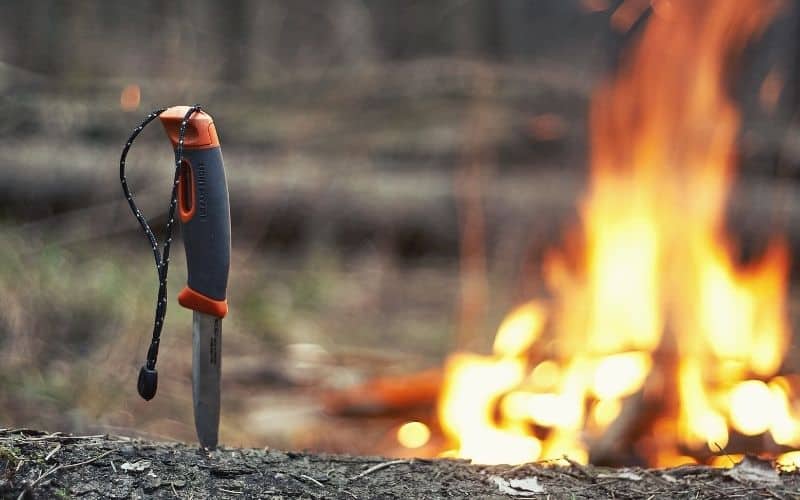
What Is A Camping Knife Used For?
The primary use of a camping knife or survival knife is cutting and shaving wood to build campfires. You can also create sparks by striking a steel or ferrocerium rod across your blade’s edge.
The second common use is as a camp cooking knife for preparing meals. If you’re going out into the wilderness for hunting or fishing, you’ll need a knife to field-dress deer or slice up fish.
Why You Should Avoid Multi-Tool Knives?
It’s a good rule of thumb to avoid multi-tool camping knives. Manufacturers who try to cram a ton of tools into one product usually compromise on the quality of the actual blade and/or end up with an ungainly device that performs poorly across the board.
If you’re a casual camper going out with friends to a maintained campground, a multi-tool might be useful. If, on the other hand, you’re a serious camper going out into the wild, you should invest in a serious camping knife.
Best Camping Knife: The Verdict
As mentioned above, finding the best camping knife for your needs is all about setting your priorities and matching these to the knives on your shortlist. However, if pushed to pick the one blade to rule them all, we’d have to plump with the Gerber Strongarm.
The Strongarm ticks all the boxes. It’s made with strong, ultra-durable high-carbon steel, retains an edge better than most competitors, is easy to handle, and comes with a highly practical sheath. No matter what chores you put it to, the Strongarm will be able to handle them.
If the Strongarm’s price tag is a little too princely for your palate, check out the Moravnik Companion. The Companion might lack a full-tang blade and come in a plasticky sheath, but we found it performed well in whatever chore we put it to and were impressed as much by its strength-to-weight ratio as we were by its low price.
So, how did you like our article? Let us know in the comments box below. And please feel free to share this post with your friends.
